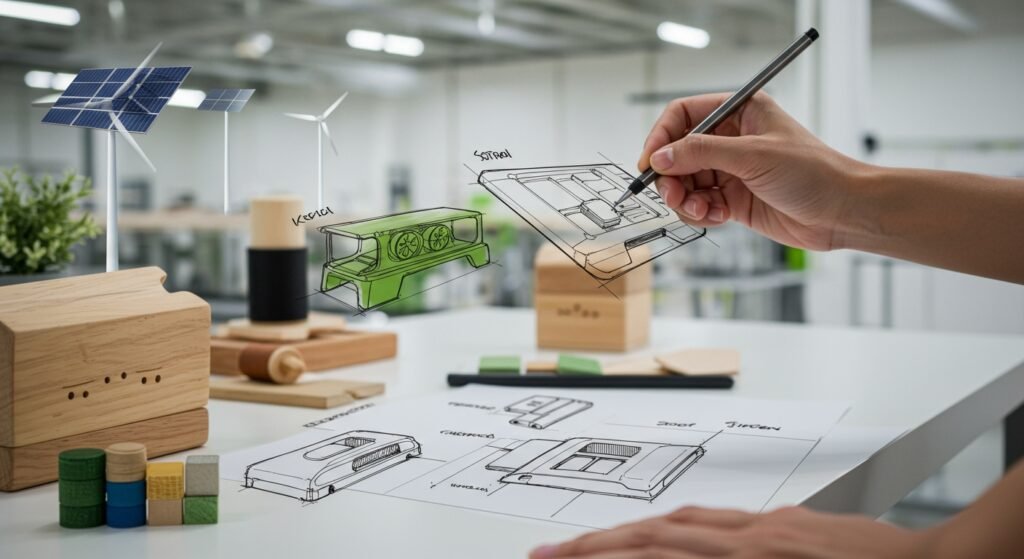Introduction to Ergonomics
Ergonomics, a discipline that combines elements of psychology, engineering, and design, is primarily concerned with understanding how people interact with their environments and the tools they use. This field focuses on optimizing human well-being and overall system performance by designing tasks, workspaces, and products that fit the individual’s needs, capabilities, and limitations. It encompasses various aspects, including physical, cognitive, and organizational ergonomics, thus influencing a wide array of domains such as healthcare, consumer products, and particularly, industrial design.
The relevance of ergonomics in industrial design cannot be overstated. In industrial environments, the relationship between workers and their tools or machines significantly impacts productivity, safety, and health. Poorly designed workstations or equipment can lead to physical strain, discomfort, and even chronic injury. On the contrary, ergonomic design prioritizes human factors, creating products and environments that enhance comfort and efficiency, ultimately leading to improved performance and reduced risk of injury. By applying ergonomic principles, designers foster better interaction between humans and systems, ensuring tasks are easier to perform and more pleasant.
An integral aspect of ergonomics is its emphasis on user-centered design. By leveraging research and analysis of user behavior, preferences, and limitations, industrial designers can create solutions tailored to the end-users. This approach results in products that not only meet functional requirements but also enhance user satisfaction and safety. Moreover, incorporating ergonomics in industrial design addresses the growing recognition of employee well-being as a fundamental contributor to organizational success, potentially lowering healthcare costs and absenteeism while boosting morale and productivity.
The Role of Ergonomics in Product Development
Ergonomics plays a pivotal role in the product development process, guiding designers to create products that are not only functional but also user-friendly and safe. By focusing on user-centered design principles, ergonomics seeks to optimize the interaction between individuals and their products, ensuring that they meet the diverse needs of users. This approach taps into the physical and cognitive capabilities of users, which is fundamental to producing effective designs.
When developing a product, understanding the demographics and specific requirements of the target audience is crucial. Ergonomic considerations encompass a variety of factors, including body size, strength, and range of motion, requiring designers to conduct thorough user research. This ensures products are accessible and comfortable for a broader range of users, thereby improving overall satisfaction and usability.
One effective methodology in ergonomic assessment is the use of anthropometric data, which involves measuring human body dimensions to inform product specifications. By applying this data, designers can create tools, furniture, and equipment that fit the human body more precisely, reducing the risk of strain or injury during use. For instance, in the design of office chairs, ergonomic principles guide the adjustment mechanics and lumbar support features to promote proper posture and comfort during extended periods of sitting.
Furthermore, ergonomic evaluations throughout the product life cycle, from initial sketching to prototype testing, facilitate iterative refinements. By incorporating feedback from user testing, developers can enhance product attributes that contribute to safety and ease of use. This continuous evaluation process helps to ensure that the final product not only functions effectively but also prioritizes the well-being of its users. Ultimately, a strong commitment to ergonomic principles in product development leads to outcomes that resonate with user expectations, promoting user engagement and long-term satisfaction.
Benefits of Ergonomic Design
Integrating ergonomic principles into industrial design is essential for enhancing the overall user experience and productivity. One of the primary benefits of ergonomic design is improved user satisfaction. When products are designed with the user’s comfort and ease of use in mind, the likelihood of user engagement and satisfaction increases significantly. For instance, ergonomic tools and equipment often lead to more intuitive interactions, providing users with a more pleasant experience during use.
In addition to user satisfaction, ergonomic design can also lead to increased productivity in various work environments. By minimizing physical strain and discomfort, ergonomically designed products allow users to perform tasks more efficiently and effectively. In cases where repetitive motions or awkward postures are common, such as in assembly lines, utilizing ergonomic tools can significantly enhance workflow. This not only benefits the individual user but can also contribute to the overall productivity of the organization.
Another critical advantage of ergonomic design is the reduction of the risk of injury. Many work-related injuries stem from poor ergonomics, including musculoskeletal disorders and repetitive strain injuries. By focusing on ergonomic solutions, manufacturers can create products that diminish the chances of such injuries occurring. This proactive approach reduces workers’ compensation costs and absenteeism related to injuries, fostering a safer workplace environment.
Lastly, ergonomic design enhances product usability by ensuring that products are intuitive and accessible to a wide range of users, including those with disabilities. By considering diverse user needs in the design phase, manufacturers can create products that are not only functional but also inclusive. This broadens the market appeal and can lead to increased sales while fulfilling ethical responsibilities toward all users. Therefore, adopting ergonomic principles in industrial design yields quantifiable and qualitative benefits that positively impact both users and manufacturers alike.
Ergonomic Principles to Consider in Design
When engaging in industrial design, it is essential to incorporate key ergonomic principles that enhance user comfort and performance. One of the primary considerations is anthropometry, which involves the study of body measurements and proportions. Understanding the variability in human body sizes can significantly influence product design, ensuring that items are accessible and usable for a broader range of individuals. For example, adjustable elements in tools and furniture allow users of varying heights and statures to work effectively without unnecessary strain.
Another crucial principle is biomechanics, which focuses on the physical interactions between humans and the products they use. This principle emphasizes the need to design objects that minimize physical stress on the body. Products should allow for natural body movements and support proper posture, thereby reducing the risk of repetitive strain injuries. Incorporating features like ergonomic grips, angled surfaces, or adjustable heights can greatly improve the user’s experience, leading to increased productivity and satisfaction.
Cognitive ergonomics is also integral to the design process. This area explores how users process information and interact with technology. Designers should ensure that interfaces are intuitive and that information is presented clearly to avoid cognitive overload. Usability testing can help identify potential obstacles in the user experience, enabling designers to create solutions that foster seamless interactions.
Furthermore, flexibility and adaptability in design are vital principles for accommodating diverse user needs. Many workplaces feature a wide range of tasks that require different ergonomic solutions. By implementing adjustable features or modular designs, products can cater to various preferences and tasks. This adaptability not only improves usability but also promotes a healthier work environment. Understanding and applying these ergonomic principles during the design process ultimately lead to successful, human-centered products that enhance overall well-being and effectiveness in industrial settings.
Case Studies of Successful Ergonomic Designs
Ergonomics plays a crucial role in enhancing both user experience and product efficacy across various industries. This section focuses on notable case studies that illustrate successful ergonomic designs, the challenges encountered, and the effective solutions applied.
One prominent case study comes from the automotive industry, which has increasingly prioritized ergonomics in vehicle design. A major car manufacturer identified that drivers often experienced discomfort during long journeys. In response, the design team implemented an innovative seating system that allowed for adjustable lumbar support, temperature control, and customizable seat positioning. User feedback indicated that these enhancements significantly improved driving comfort and reduced fatigue, ultimately leading to higher customer satisfaction and increased sales.
In the realm of office furniture, a leading company developed a new line of ergonomic chairs to address widespread reports of back pain among employees. Through comprehensive research, they found that traditional office chairs did not provide adequate lumbar support or adjustability. The company’s solution involved creating a chair that featured adjustable armrests, seat depth, and dynamic lumbar support. The result of this ergonomic redesign not only led to a notable decrease in reported back pain among users but also improved overall productivity, as users experienced greater comfort during extended work hours.
Another illuminating case comes from the consumer electronics sector, where a tech company sought to enhance the usability of handheld devices. User studies revealed that the existing designs were prone to causing strain in the hands and wrists after prolonged use. By employing ergonomic principles, the design team reshaped the device to be more comfortable to hold and included a user-friendly interface that minimized the effort needed for navigation. Post-launch evaluations indicated a significant decrease in user complaints regarding hand discomfort, demonstrating the effectiveness of incorporating ergonomics into the design process.
These case studies exemplify the substantial benefits that ergonomic design can provide, not only in improving user satisfaction but also in bolstering the commercial success of products within their respective markets.
Challenges in Implementing Ergonomics
Implementing ergonomic principles in industrial design presents several challenges, often rooted in misconceptions and practical limitations. One of the primary barriers designers face is budget constraints. Many organizations prioritize cost reduction over investing in ergonomic solutions, viewing them as additional expenses rather than critical improvements that enhance productivity and safety. This shortsightedness can lead to poorly designed products that fail to meet the users’ needs, ultimately resulting in higher costs associated with injuries and inefficiencies.
Another significant challenge is the lack of awareness about ergonomics among designers and stakeholders. Not everyone involved in the design process fully understands the importance of ergonomic considerations, which can lead to neglecting essential aspects during product development. This lack of awareness can stem from insufficient emphasis on ergonomics in educational programs or professional training, leaving designers ill-equipped to make informed decisions about user-centric design.
Moreover, insufficient training on ergonomic principles can further hinder the effective application of these concepts. Designers may be familiar with the basics yet lack the expertise to analyze complex interactions between users and products. This gap in knowledge not only affects the design process but can also diminish the potential benefits of ergonomic interventions, such as increased comfort, reduced fatigue, and improved overall user experience.
To overcome these challenges, it is essential for organizations to foster a culture that values ergonomics from the outset of product development. Providing comprehensive training and resources on ergonomic principles can empower designers and stakeholders alike to integrate these approaches more effectively. Additionally, adopting a long-term perspective on investment in ergonomics can help companies to appreciate the potential returns in terms of enhanced productivity and reduced injury rates. By addressing these challenges, organizations can successfully implement ergonomic principles, leading to improved design outcomes that prioritize user well-being.
Future of Ergonomics in Industrial Design
The future of ergonomics in industrial design is poised to undergo significant transformations driven by advanced technologies, sustainability initiatives, and an evolving understanding of user demographics. As industries increasingly integrate artificial intelligence (AI) and virtual reality (VR) into design processes, the potential for enhanced ergonomic solutions becomes more pronounced. AI can analyze vast amounts of data to identify optimal design parameters that cater to various user needs, while VR enables designers to create immersive environments where user interactions can be simulated and assessed before finalizing products. This technology aids in creating solutions that are not only efficient but also user-focused from the outset.
Sustainability is another critical trend shaping the future of ergonomics in industrial design. Designers are increasingly adopting eco-friendly materials and processes that minimize waste and environmental impact while ensuring that products remain ergonomically beneficial. This commitment to sustainability is anticipated to foster innovations that harmonize user well-being with ecological responsibility. By integrating ergonomic principles with sustainable practices, designers can create products that not only improve user experience but also contribute positively to environmental conservation.
Furthermore, as society grows more diverse, the understanding of user demographics continues to evolve. Ergonomics will inevitably expand to include a wider range of populations, such as aging adults and people with disabilities. This shift necessitates a more inclusive design approach, ensuring that all users have access to comfortable and functional products. Designers will need to employ research methods that emphasize collaboration with various user groups to better grasp their unique needs. By recognizing these demographic changes, ergonomic design in industrial contexts can become increasingly adaptive and effective.
As we look to the future, the integration of advanced technologies, commitment to sustainability, and recognition of diverse user demographics will significantly influence ergonomics in industrial design, paving the way for innovative and user-centric products.
Guidelines for Designers
Incorporating ergonomic principles into industrial design is essential for ensuring user comfort, safety, and efficiency. To assist designers in this objective, a set of practical guidelines can serve as a robust framework for their work. These guidelines encompass checklists, tools, and resources that focus on enhancing the understanding and application of ergonomics.
First, designers should start with an ergonomic checklist that includes assessing the dimensions and spatial arrangements of the product. Key aspects to consider involve the anthropometric data of target users, such as height, reach, and strength. Designers can benefit from consulting resources like the Human Factors and Ergonomics Society, which provides valuable anthropometric databases tailored for various demographics. This data can guide the design process, ensuring that the product accommodates a wide range of users.
Furthermore, it is vital to incorporate feedback mechanisms into the design cycle. Engaging with users during prototype testing is an effective way for designers to gather insights regarding comfort and usability. This iterative process enables designers to make necessary adjustments based on real-world experiences, aligning the product more closely with ergonomic standards.
In addition to checklists, employing digital tools and software can significantly enhance the ability to evaluate ergonomic factors. Tools such as CAD software with integrated ergonomic features can help visualize spatial arrangements, optimizing the product for user interaction. Ergonomics evaluation tools also allow for simulations that predict potential issues before physical prototypes are built.
Lastly, continuous education is crucial for designers striving to apply ergonomic principles effectively. Workshops, online courses, and professional memberships can provide ongoing learning opportunities that keep designers informed about the latest ergonomics research and trends. By actively integrating these guidelines into their work, designers can create products that prioritize user well-being and safety in an industrial setting.
Conclusion
In conclusion, the significance of ergonomics in industrial design cannot be overstated. This discipline plays a pivotal role in shaping products that not only meet aesthetic standards but also significantly improve user comfort and functionality. Throughout this blog post, we have explored the multifaceted benefits of integrating ergonomic principles into product development, highlighting how such practices can enhance user experience and ensure better overall outcomes. Ergonomically designed products tend to lead to increased satisfaction, reduced risk of injury, and higher efficiency among users.
Moreover, the discussion around ergonomics emphasizes the need for designers to remain attuned to the physical and cognitive capabilities of users. By understanding user behavior and needs, designers can create solutions that prioritize ease of use and accessibility. This not only fosters a more engaging experience for users but also promotes inclusivity in design, ensuring that products cater to a wider audience.
The incorporation of ergonomic considerations affects various aspects like the shape, size, and layout of products, enabling them to fit seamlessly into the lives of users. It is imperative that designers adopt an ergonomic mindset throughout the design process—from conceptualization to production—to yield products that are not only functional but also user-friendly. Therefore, designers are encouraged to stay informed about the latest ergonomic research and trends to apply best practices in their work.
Moving forward, we urge all designers involved in industrial design to consider ergonomics as a foundational element in their projects. By prioritizing ergonomic factors, designers can contribute to creating a safer, more pleasurable, and efficient environment for users. Start implementing these ergonomic principles in your design practices today to make a lasting impact in the field of industrial design.


